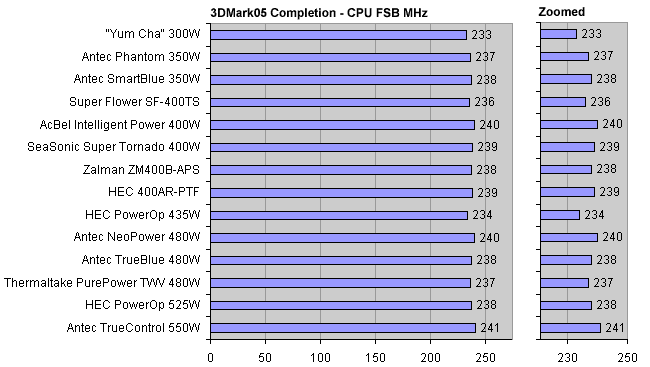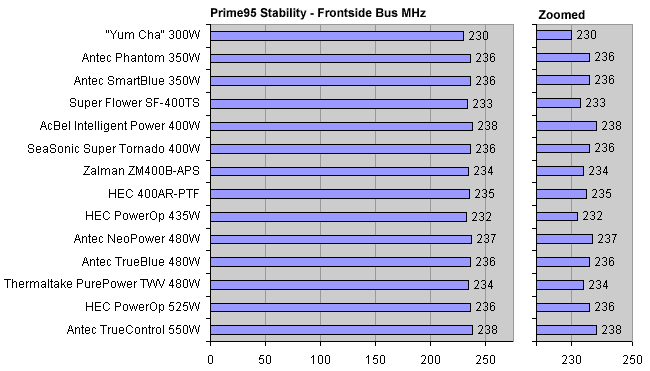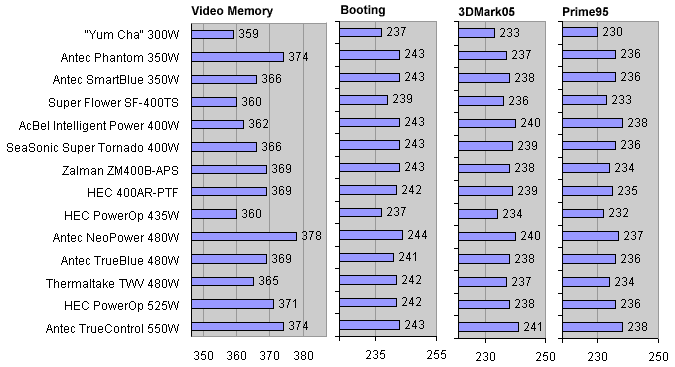|
|
Advertisement:
|
|
Thirteen PSU Roundup |
|
Join the community - in the OCAU Forums!
|
More Testing, Performance Summary and Conclusions
3DMark2005 is a well-known 3D benchmark aimed at simulating gaming-oriented tasks. It's a fairly long stress-test of most components, particularly the video card, but also main memory and the CPU, as well as loading quite a bit of data from the HDD. The system had to load Win2k, load 3DMark2005 and complete a full benchmark run. Then it had to shutdown cleanly and reboot into the BIOS setup menu to count as a "pass".

Again, a spread of results, but nothing really leaps out. The problem with 3DMark2005 as a stability test is that it's not particularly sensitive to errors. Sometimes the machine will display an error (usually some DirectX issue), or it will drop out of 3DMark and back to the desktop, or sometimes it will reboot spontaneously. However, unless you are staring at the PC for all the testing runs, you might miss other errors such as graphics glitches, corrupted textures etc, which don't affect the completion of the test run. Other errors may occur without any obvious indication at all, and 3DMark may continue on for a "pass" result.
We used Prime95 as the final, most sensitive test. This is actually part of a distributed computing project to search for very large prime numbers. However, it's grown to be widely regarded as one of the most sensitive stability-testing tools available. In recognition of this usage, the authors have included a "Torture Test" mode which runs intensive numerical calculations and compares the calculated result with known correct results. If a difference is found, the program aborts and informs you of the error. It's highly sensitive to errors within the CPU, the cache or system memory. We used the default "Blend" mode and let it complete the first sequence of tests, for a bit over 10 minutes of continuous testing each run. Normally you would test overnight, or for 24 hours, but that time frame is impossible with the number of test runs we must complete. Any reported errors counted as a fail. The highest successful CPU FSB speed for each PSU was recorded.

Performance Summary:
The results are surprisingly close across all our tests. Some of them you could consider as falling within the range of experimental error. However, there are some trends common to all the testing, which are more easily identified if we collate our "zoomed" graphs:

Here we see some clear trends. The Antec PSUs fared consistently well, appearing at or near the top in all tests. This is encouraging, because we've been using and recommending Antec PSUs for a while now, so it's nice to see those experiences backed up with some experimental results. That they now offer a wider range of features such as silent, modular and adjustable-voltage PSUs is a definite bonus for those who don't just want a plain grey box PSU.
HEC as a relative newcomer also did well with their 525W unit, but the 435W one disappointed due to what seems to be a hypersensitive cutout. AcBel were a surprise, with their 400W unit recording results well up with the higher-rated group. This is a good first showing from them and we hope to see more from them in future. The Thermaltake, Zalman and SeaSonic units made up the mid-range, while the Super Flower lagged behind a little. It's interesting that the ATX 2.0 compatible units all returned good results, despite our test system not requiring ATX 2.0 compatability - however not all the PSUs that fared well were ATX 2.0, for example the SmartBlue 350W.
Conclusions:
I must note that I don't feel we have really isolated a good "real world" test for PSUs during this roundup. The results are down to only a few MHz of difference across the entire sample set in places. You might suggest that our testbed was not power-hungry enough to produce good results, but this is a Prescott P4 running at around 3.8GHz. The Radeon 9800 Pro video card and 3 hard drives also contribute a fair amount of power usage. I don't think anyone would recommend a generic 400W PSU for this kind of system, if your intention was to overclock it to its limits. However, we found that even the 350W Antec units were well up there in the results.
It's a little unfair to pick one "winner", because as mentioned in the introduction we had no stated critera for these PSUs. They're a random sample that have been sent to us over time and collated in this article simply because they were at hand. They're aimed in some cases at different markets and have a range of stated power ratings. However, the one standout for me is the Antec NeoPower 480W. The "modular" aspect is very cool, although admittedly there are other manufacturers with modular PSUs. The low noise technology is good, but other PSUs have that and one tested today was even totally fanless. However, beside these features which you might dismiss as gimmicks, the NeoPower fared very strongly in our testing, ranking right up there with the adjustable TrueControl unit. It's the combination of configurability, features and performance that make the NeoPower 480W the real eye-catcher in this roundup, for me.
The "Yum Cha" PSU warrants some mention here. During 3DMark2005 testing it was obviously overloaded in a way that would be clear to any observer. The system surged and lagged, with bursts of on-screen speed and noticeable slowdowns. In sync with these lags was a noticeable dip in the sound from our two 120mm fans and, most worryingly, an audible whine from the PSU itself! I genuinely feared for the well-being of our test system, expecting the PSU to explode at any point and take out a few other components. However, it completed our testing, and not hugely far below the MHz results of the other PSUs, despite behaving in a way that nobody would tolerate in their system. This isn't meant to be praise for the poor tortured unit, but rather some self-criticism of our testing. How is it that we can observe a PSU clearly failing to cope, but aren't able to demonstrate that with some more dramatically tangible results? It's something we'll consider for our next PSU roundup, with our next long-term testbed. This is likely to be a firebreathing S939 A64 system, possibly with SLi video cards. This will also give us the opportunity to examine some of the very high rated ATX 2.0 compatible PSUs that have appeared on the market lately, at 600W and above.
|
|
Advertisement:
All original content copyright James Rolfe.
All rights reserved. No reproduction allowed without written permission.
Interested in advertising on OCAU? Contact us for info.
|

|


